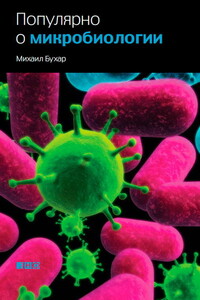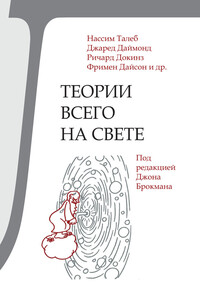Мой неповторимый геном [заметки]
1
Зипрекса — антипсихотический препарат (нейролептик) с широким спектром действия. (Примеч. ред.)
2
Henderson, Mark. 2009. Genetic Mapping of Babies by 2019 Will Transform Preventive Medicine. Times (9 February).
3
Издана в России: Джеймс Уотсон. Избегайте занудства. — М.: Corpus, 2010. (Примеч. ред.)
4
Hunt-Grubbe, Charlotte. 2007. The Elementary DNA of Dr Watson. Sunday Times (14 October).
5
Conniff, Richard. 2006. Discover Interview: E. O. Wilson. Discover magazine (24 June).
6
Wade, Nicholas. 2009. Hoopla, and Disappointment, in Schizophrenia Research. New York Times, TierneyLab Blog (1 July). http://tierneylab.blogs.nytimes.com/2009/07/01/hoopla-and-disappointment-in-schizophrenia-research.
7
Watson, James D. The Double Helix: A Personal Account of the Discovery of the Structure of DNA. New York: Touchstone, p. 197.
8
Это касается даже однояйцовых близнецов. Исходно нуклеотидные последовательности их геномов идентичны, но благодаря мутациям и особенно генетическим модификациям, накапливающимся в течение всей жизни, геномы все больше расходятся. Об эпигенетических факторах речь пойдет в гл. 7. (Примеч. пер.)
9
Clinton, Bill. 2000. White House press conference (26 June). Transcript available at http://www.dnalc.org/view/15073-Completion-of-a-draft-of-the-human-genome-Bill-Clinton.html
10
Shreeve, James. 2004. The Genome War: How Craig Venter Tried to Capture the Code of Life and Save the World. New York: Alfred A. Knopf.
11
Klein, Robert J. 2005. Complement Factor H Polymorphism in Age-related Macular Degeneration. Science 308(5720): 385-9.
12
Sladek, Robert, et al. 2007. A Genome-wide Association Study Identifies Novel Risk Loci for Type 2 Diabetes. Nature 445: 881-5.
13
Wellcome Trust Case Control Consortium. 2007. Genome-wide Association Study of 14,00 °Cases of Seven Common Diseases and 3,000 Shared Controls. Nature 447(7145): 661-78.
14
Pinker, Steven. 2009. My Genome, My Self. New York Times Magazine (7 January).
15
Homes, A. M. 2007. The Mistress’s Daughter: A Memoir. New York: Viking.
16
Padawer, Ruth. 2009. Who Knew I Was Not the Father? New York Times Magazine (17 November).
17
Goffe, Leslie. 2009. Americans Seek Their African Roots. BBC Focus on Africa (29 June). http://news.bbc.co.uk/1/hi/8117258.stm.
18
Indigenous Peoples Council on Biocolonialism. Genographic Project Director Spencer Wells, IBM Lead Scientist Ajay Royyuru Answer Questions about the Project. http://www.ipcb.org/issues/human_genetics/htmls/geno_q&a.html
19
Zalloua, Pierre A., et al. 2008A. Identifying Genetic Traces of Historical Expansions: Phoenician Footprints in the Mediterranean. American Journal of Human Genetics 83(5): 633-42.
20
Zalloua, Pierre A., et al. 2008B. Y-chromosomal Diversity in Lebanon Is Structured by Recent Historical Events. American Journal of Human Genetics 82(4): 873.
21
Balaresque, Patricia, et al. 2010. A Predominantly Neolithic Origin for European Paternal Lineages. PLoS Biology 8(1): 1–9.
22
Hammer, Michael, et al. Y Chromosomes of Jewish Priests. Nature 385(6611): 32.
23
Harmon, Amy. 2007. Stalking Strangers’ DNA to Fill in the Family Tree. New York Times (2 April).
24
Kiemeney, Lambertus A. A., et al. 2008. Sequence Variant on 8q24 Confers Susceptibility to Urinary Bladder Cancer. Nature Genetics 40(11): 1307-11.
25
Hunter, David J., et al. 2008. Letting the Genome out of the Bottle: Will We Get Our Wish? New England Journal of Medicine 358: 105-7.
26
Kong, Augustine, et al. 2009. Parental Origin of Sequence Variants Associated with Complex Diseases. Nature 462: 868-74.
27
Long, Camilla. 2010. When DNA Means Do Not Ask. Sunday Times (14 March).
28
Gudbjartsson, Daniel F., et al. 2009. A Sequence Variant in ZFHX3 on 16q22 Associates with Atrial Fibrillation and Ischemic Stroke. Nature Genetics 41(8): 876-8.
29
Check Hayden, Erika. 2010. The Human Genome at Ten. Nature 464(1): 664-7.
30
Green, Robert C., et al. 2009. Disclosure of APOE Genotype for Risk of Alzheimer’s Disease. New England Journal of Medicine 361:245-54.
31
Bloss, Cinnamon S., et al. 2011. Effect of Direct-to-Consumer Genomewide Profiling to Assess Disease. New England Journal of Medicine 359: 2192-3.
32
Tierney, John. 2011. Heavy Doses of DNA Data, With Few Side Effects. New York Times (17 January).
33
McCarty, Catherine A. 2009. To Share or Not to Share: That Is the Question. Genomics Law Report (15 Oct). http://www.genom-icslawreport.com
34
Davies, Kevin. 2009. Linda Avey on an Alzheimer’s Brainstorm. Bio-ITWorld.com (24 November). http://www.bio-itworld.com/news/11/24/09/Linda-Avey-Alzheimers-brainstorm.html
35
McCabe, Jen. 2009. Exploring the ‘Me-ome’ 23andMe Research Revolution Results. Health Management Rx Blog (23 July). http://hmrx.posterous.com/jensmccabe-exploring-the-me-ome-23a.
36
MacArthur, Daniel. 2009. 23andMe Launches New Effort to Recruit Patients for Disease Gene Studies. Genetic Future Blog (7 July). http://scienceblogs.com/geneticfuture/2009/07/23andme_launches_new_effort_to.php
37
Eriksson, Nicholas, et al. 2010. Web-based, Participant-driven Studies Yield Novel Genetic Associations for Common Traits. PLoS Genetics 6(6): e1000993.
38
Newsweek. 2007. The 10 Hottest Nerds. Newsweek (9 October).
39
Zimmer, Carl. 2010. A Day Among the Genomes. Discover The Loom Blog (3 May).
40
Personal Genome Project. PGP-10. http://www.personalgenomes.org/pgp10.html
41
Wells, H.G. 1920 (reprinted 1976). The Outline of History: Being a Plain History of Life and Mankind. St. Clair Shores, Mich.: Scholarly Press.
42
Green, Robert C., and George J. Annas. 2008. The Genetic Privacy of Presidential Candidates. New England Journal of Medicine 359: 2192-3.
43
Holden, Constane. 2008. Parsing the Genetics of Behavior. Science 322(5903): 892-5.
44
Turkheimer, Eric. 2000. Three Laws of Behavior Genetics and What They Mean. Current Directions in Psychological Sciences 9: 160-4.
45
Iervolino, Alessandra C., et al. 2009. Prevalence and Heritability of Compulsive Hoarding: A Twin Study. American Journal of Psychiatry 166: 1156-61.
46
Koenig, Laura B., et al. 2005. Genetic and Environmental Influences on Religiousness: Findings for Retrospective and Current Religiousness Ratings. Journal of Personality 73(2): 471-88.
47
Alford, John R., et al. 2005. Are Political Orientations Genetically Transmitted? American Political Science Review 99: 153-67.
48
Fowler, James H., and Darren Schreiber. 2008. Biology, Politics, and the Emerging Science of Human Nature. Science 322(5903): 912-4.
49
McLaughlin, John. 2008. 2008 Year-End Awards. The McLaughlin Group (27–28 December). Transcript available at http://www.mclaughlin.com/transcript.htm?id=697
50
Fowler, James H., et al. 2008. Genetic Variation in Political Participation. American Political Science Review 102: 233-48.
51
Hamer, Dean H., et al. 1993. A Linkage between DNA Markers on the X Chromosome and Male Sexual Orientation. Science 261(5119): 321-7.
52
Brunner, Han G., et al. 1993. Abnormal Behavior Associated with a Point Mutation in the Structural Gene for Monoamine Oxidase A. Science 262(5133): 578-80.
53
Benjamin, Jonathan, et al. 1996. Population and Familial Association between the D4 Dopamine Receptor Gene and Measures of Novelty Seeking. Nature Genetics 12(1): 81-4. Ebstein, Richard P., et al. 1996. Dopamine D4 Receptor (D4DR) Exon III Polymorphism Associated with the Human Personality Trait of Novelty Seeking. Nature Genetics 12(1): 78–80.
54
Lesch, Klaus-Peter, et al. 1996. Association of Anxiety-related Traits with a Polymorphism in the Serotonin Transporter Gene Regulatory Region. Science 274(5292): 1527-31.
55
Ben Zion, Itzhak Zahy, et al. 2006. Polymorphisms in the Dopamine D4 Receptor Gene (DRD4) Contribute to Individual Differences in Human Sexual Behavior: Desire, Arousal and Sexual Function. Molecular Psychiatry 11(8): 782-6.
56
Butcher, Lee M., et al. 2008. Genomewide Quantitative Trait Locus Association Scan of General Cognitive Ability Using Pooled DNA and 500K Single Nucleotide Polymorphism Microarrays. Genes, Brain and Behavior 7(4): 435–446.
57
Sullivan, Patrick F. 2000. Genetic Epidemiology of Major Depression: Review and Meta-Analysis. American Journal of Psychiatry 157:1552–1562.
58
Risch, Neil, et al. 2009. Interaction Between the Serotonin Transporter Gene (5-HTTLPR), Stressful Life Events, and Risk of Depression. Journal of the American Medical Association 301(23): 2462-71.
59
Lacasse, Jeffrey R., and Jonathan Leo. 2005. Serotonin and Depression: A Disconnect between the Advertisements and Scientific Literature. PLoS Medicine 2(12): 101-6.
60
Aamodt, Sandra, and Sam Wang. 2009. Mugged by Our Genes? New York Times Opiniontator Blog (24 March). http://opiniona-tor.blogs.nytimes.com/2009/03/24/guest-column-mugged-by-our-genes
61
Beaver, Kevin M., et al. 2009. Biosocial Development and Delinquent Involvement. Youth Violence and Juvenile Justice 7: 223-38.
62
Hariri, Ahmad R., et al. 2002. Serotonin Transporter Genetic Variation and the Response of the Human Amygdala. Science 297: 400-3.
63
Eisenberger, Naomi, et al. 2007. Understanding Genetic Risk for Aggression: Clues from the Brain’s Response to Social Exclusion. Biological Psychiatry 61: 1100-8.
64
McHughen, Stephanie A., et al. 2009. BDNF Val>66Met Polymorphism Influences Motor System Function in the Human Brain. Cerebral Cortex (10 September).
65
Pezawas, L., et al. 2008. MET BDNF Protects Against Morphological S Allele Effects of 5-HHTLPR. Molecular Psychiatry 13(654): 709-16.
66
Sjoberg, Rikard L., et al. 2008. A Non-additive Interaction of a Functional MAO-A VNTR and Testosterone Predicts Antisocial Behavior. Neuropsychopharmacology 33(2): 425-30.
67
Caspi, Avshalom, et al. 2008. A Replicated Molecular Genetic Basis for Subtyping Antisocial Behavior in Children with AttentionDeficit/Hyperactivity Disorder. Archives of General Psychiatry 65(2): 203-10.
68
Turkheimer, Eric. 2000. Three Laws of Genetic Behaviors. Current Directions in Psychological Science 9(5): 160-4.
69
Nettle, Daniel. 2007. Personality: What Makes You the Way You Are. Oxford: Oxford University Press, p. 43.
70
Galton, Francis. 1884. The Measurement of Character. Fortnightly Review 36: 179-85.
71
Allport, Gordon W., and H. S. Odbert. 1936. Trait Names: A Psycho-lexical Study. Psychological Monographs 47(211).
72
Tupes, Ernest C., and Raymond E. Cristal. 1961. Recurrent Personality Factors Based on Trait Raitings. Technical Report ASD-TR-61-97. Lackland Air Force Base, TX: Personnel Laboratory, US Air Forces Systems Command. Norman, Warren T. 1963. Toward an Adequate Taxonomy of Personality Attributes: Replicated Factor Structure in Peer Nomination Personality Ratings. Journal of Abnormal and Social Psychology 66: 574-83.
73
Costa, Paul T., Jr., and Robert R. McCrae. 1988. Personality in Adulthood: A Six-year Longitudinal Study of Self-reports and Spouse ratings on the NEO Personality Inventory. Journal of Personality and Social Psychology 54(5): 853-63.
74
Saulsman, Lisa M., and Andrew C. Page. 2004. The Five-Factor Model and Personality Disorder Empirical Literature: A Meta-Analytic Review. Clinical Psychology Review 23(8): 1055-85.
75
Conard, Maureen A. 2006. Aptitude Is Not Enough: How Personality and Behavior Predict Academic Performance. Journal of Research in Personality 40(3): 339-46.
76
Barrick, Murray R., and Michael K. Mount. 1991. The Big Five Personality Dimensions and Job Performance: A Meta-Analysis. Personnel Psychology 44: 1-26.
77
Bouchard, Thomas J. and Matt McGue. 2003. Genetic and Environmental Influences on Human Psychological Differences. Journal of Neurobiology 54: 4-45.
78
Plomin, Robert, et al. 2001. Why Are Children in the Same Family So Different? Nonshared Environment a Decade Later. Canadian Journal of Psychiatry 46: 225-33.
79
Plomin, Robert, and Denise Daniels. 1987. Why Are Children from the Same Family So Different from One Another? Behavioral and Brain Sciences 10: 1-60.
80
Nettle, Daniel. 2007. Personality, p. 216.
81
Quoted in Holden, Constance. 2008. Parsing the Genetics of Behavior. Science 322(5903): 892-5.
82
Seed. 2009. Revolutionary Minds: The Re-envisionaries. http://revminds.seedmagazine.com/revminds/member/heejung_kim
83
Kim, Heejung S., et al. 2010. Culture, Serotonin Receptor Polymorphism and Locus of Attention. Social, Affective and Cognitive Neuroscience 5(2–3): 212-8.
84
Shalev, Idan, et al. 2009. BDNF Val66Met Polymorphism Is Associated with HPA Axis Reactivity to Psychological Stress Characterized by Genotype and Gender Interactions. Psychoneuroendocrinology 34(3): 382-8.
85
Kalbitzer, Jan, et al. 2009. The Personality Trait Openness Is Related to Cerebral 5-HTT Levels. Neuroimage 45(2): 280-5.
86
See Aron, Elaine N. 1997. The Highly Sensitive Person: How to Thrive When the World Overwhelms You. New York: Broadway Books.
87
IMAGEN Project. 2007. The IMAGEN Study Has Started at the End of December 2007. IMAGEN Website press release (11 December). http://www.imagen-europe.com/en/imagen-study.php
88
Belsky, Jay, and Michael Pluess. 2009. Beyond Diathesis Stress: Differential Susceptibility to Environmental Influences. Psychological Bulletin 135(6): 885–908.
89
Boyce, W. Thomas, and Bruce J. Ellis. 2005. Biological Sensitivity to Context: An Evolutionary-developmental Theory of the Origins and Functions of Stress Reactivity. Developmental Psychopathology 17(2): 271–301.
90
Kinnally, Erin L., et al. 2009. Parental Care Moderates the Influence of MAOA-uVNTR Genotype and Childhood Stressors on Trait Impulsivity and Aggression in Adult Women. Psychiatric Genetics 19(3): 126-33.
91
Pinker, Steven. 2009. My Genome, My Self. New York Times Magazine (7 January).
92
Bazelon, Emily. 2006. A Question of Resilience. New York Times Magazine (April 30).
93
Schardt, Dina M. 2010. Volition Diminishes Genetically Mediated Amygdala Hyperreactivity. Neuroimage 53: 943-51.
94
Fraga, Mario F., et al. 2005. Epigenetic Differences Arise during the Lifetime of Monozygotic Twins. Proceedings of the National Academy of Sciences 102(30): 10604-9.
95
Weaver, Ian C. G., et al. 2004. Epigenetic Programming by Maternal Behavior. Nature Neuroscience 7: 847-54.
96
McGowan, Patrick O., et al. 2009. Epigenetic Regulation of the Glucocorticoid Receptor in Human Brain Associates with Childhood Abuse. Nature Neuroscience 12(3): 342-8.
97
Oberlander, Tim F., et al. 2008. Prenatal Exposure to Maternal Depression, Neonatal Methylation of Human Glucocorticoid Receptor Gene (NR3C1) and Infant Cortisol Stress Responses. Epigenetics 3(2): 97-106.
98
PricewaterhouseCoopers. 2009. Pharma 2020: Challenging Business Models (April). http://www.pwc.com/gx/en/pharma-life-sciences/pharma-2020-business-models
99
Quoted in Jaroff, Leon J. 1989. The Gene Hunt. Time (20 March): 62-7.
100
Wedekind, Claus, et al. 1995. MHC-dependent Preferences in Humans. Proceedings of the Royal Society London B 260: 245-9.
101
Ober, Carole, et al. 1997. HLA and Mate Choice in Humans. American Journal of Human Genetics 61(3): 497–504.
102
Chaix, Rapha6lle, et al. 2008. Is Mate Choice in Humans MHC-dependent? PLoS Genetics 4(9): 1–5.
103
Chaix, Rapha6lle, et al. 2008. Is Mate Choice in Humans MCH-dependent? PLoS Genetics 4(9): e1000184. doi:10.1371/journal. pgen.1000184
104
Ihara, Yasuo, et al. 2000. HLA and Human Mate cChoice: Tests on Japanese Couples. Anthropological Science 108: 199–214.
105
Havlicek, Jan, and S. Craig Roberts. 2009. MHC-correlated Mate Choice in Humans: A Review. Psychoneuroendocrinology 34(4): 497–512.
106
Garver-Apgar, Christine, et al. 2006. MHC Alleles, Sexual Re-sponsivity, and Unfaithfulness in Romantic Couples. Psychological Sciences 17: 830-5.
107
Walum, Hasse, et al. 2008. Genetic Variation in the Vasopressin Receptor 1A Gene (AVPR1A) Associates with Pair-bonding Behavior in Humans. PNAS — Proceedings of the National Academy of Sciences 105(37): 14153-6.
108
Risch, Neil, et al. 2009. Ancestry-related Assortative Mating in Latino Populations. Genome Biology 10(11): R132.
109
Quoted in Aldous, Peter. 2009. Guapa, It’s Your Genetic Ancestry I Love. New Scientist (20 November).
110
Parker, Randall. 2010. Counsyl Genetic Tests for Prospective Parents. FuturePundit Blog (2 February). http://www.futurepundit. com/archives/006920.html
111
Leroi, Armand M. 2006. The Future of Neo-eugenics. EMBO Reports 7(12): 1184-7.
112
Marchione, Marilynn. 2010. Gene Testing Spurs Decline of Some Dire Diseases. Associated Press (19 February).
113
Pollack, Andrew. 2010. Firm Brings Gene Test to Masses. New York Times (28 January).
114
Quoted in Counsyl. 2010. Counsyl Test to Prevent Diseases Like Those in ‘Extraordinary Measures’ Now at 100+ Medical Centers. Press release (22 January).
https://www.counsyl.com/pr/counsyl-test-to-prevent-diseas-es-like-those-in-extraordinary-measures-now-at-100-medical-centers
115
Lohmueller, Kirk E., et al. 2008. Proportionally More Deleterious Genetic Variation in European than in African Populations. Nature 451: 994-7.
116
London Sperm Bank. 2011. Looking for Donated Sperm? http://www.londonspermbank.com/looking_for_donated_sperm.html
117
Goldstein, David B. 2010. Personalized Medicine. Nature 463: 26–32.
118
Rask Larsen, Julie. 2008. Dansk abortlov er forsldet og krsn-kende (Danish Abortion Law Is Outdated and Offensive). Politiken (25 August). http://politiken.dk/debat/kroniker/ECE556702/dansk-abortlov-er-foraeldet-og-kraenkende
119
Appel, Jacob M. 2009. Mandatory Genetic Testing Isn’t Eugenics, It’s Smart Science. Opposing Views (4 March). http://www.opposingviews.com/i/mandatory-genetic-testing-isn-t-eugenics-it-s-smart-science
120
Singh, Ilina, and Nikolas Rose. 2009. Biomarkers in Psychiatry. Nature 460 (9): 202-7.
121
Brody, Gene H., et al. 2009. Prevention Effects Moderate the Association of 5-HTTLPR and Youth Risk Behavior Initiation: Gene x Environment Hypotheses Tested via a Randomized Prevention Design. Child Development 80(3): 645-61.
122
Rafter, Nicole. 2008. The Criminal Brain: Understanding Biological Theories of Crime. New York: New York University Press, p. 246.
123
Ibid., p. 16.
124
Lahn, Bruce T., and Lanny Ebenstein. 2009. Let’s Celebrate Human Genetic Diversity. Nature 461(18): 726-8.
125
Rose, Steven. 2009. Darwin 200: Should Scientists Study Race and IQ? No: Science and Society Do Not Benefit. Nature 457: 786-8.
126
Way, Baldwin M. and Lieberman, Matthew D. 2010. Is there a genetic contribution to cultural differences? Collectivism, individualism and genetic markers of social sensitivity. Social Cognitive and Affective Neuroscience 5(2–3): 203-11.
127
Lieberman, Matthew D. 2009. What Makes Big Ideas Sticky? In Brockman, Max, ed. What’s Next?: Dispatches from the Future of Science. New York: Vintage, pp. 89-103.
128
Fowler, James H., and Darren Schreiber. 2008. Biology, Politics, and the Emerging Science of Human Nature. Science 322(5903): 912-4.
129
Hacking, Ian 2009. Current Controversies: Ian Hacking. On the Human Blog (30 March). http://onthehuman.org/2009/03/cur-rent-controversies-ian-hacking

Петр Ильинский, уроженец С.-Петербурга, выпускник МГУ, много лет работал в Гарвардском университете, в настоящее время живет в Бостоне. Автор многочисленных научных статей, патентов, трех книг и нескольких десятков эссе на культурные, политические и исторические темы в печатной и интернет-прессе США, Европы и России. «Легенда о Вавилоне» — книга не только о более чем двухтысячелетней истории Вавилона и породившей его месопотамской цивилизации, но главным образом об отражении этой истории в библейских текстах и культурных образах, присущих как прошлому, так и настоящему.

Научно-популярный журнал «Открытия и гипотезы» представляет свежий взгляд на самые главные загадки вселенной и человечества, его проблемы и открытия. Никогда еще наука не была такой интересной. Представлены теоретические и практические материалы.

«Что такое на тех отдаленных светилах? Имеются ли достаточные основания предполагать, что и другие миры населены подобно нашему, и если жизнь есть на тех небесных землях, как на нашей подлунной, то похожа ли она на нашу жизнь? Одним словом, обитаемы ли другие миры, и, если обитаемы, жители их похожи ли на нас?».

Взыскание Святого Грааля, — именно так, красиво и архаично, называют неповторимое явление средневековой духовной культуры Европы, породившее шедевры рыцарских романов и поэм о многовековых поисках чудесной лучезарной чаши, в которую, по преданию, ангелы собрали кровь, истекшую из ран Христа во время крестных мук на Голгофе. В некоторых преданиях Грааль — это ниспавший с неба волшебный камень… Рыцари Грааля ещё в старых текстах именуются храмовниками, тамплиерами. История этого католического ордена, основанного во времена Крестовых походов и уничтоженного в начале XIV века, овеяна легендами.

В занимательной и доступной форме автор вводит читателя в удивительный мир микробиологии. Вы узнаете об истории открытия микроорганизмов и их жизнедеятельности. О том, что известно современной науке о морфологии, методах обнаружения, культивирования и хранения микробов, об их роли в поддержании жизни на нашей планете. О перспективах разработок новых технологий, применение которых может сыграть важную роль в решении многих глобальных проблем, стоящих перед человечеством.Книга предназначена широкому кругу читателей, всем, кто интересуется вопросами современной микробиологии и биотехнологии.

«Напишите о вашем самом любимом, самом интересном, глубоком и изящном объяснении», – попросил издатель и писатель Джон Брокман известнейших ученых всего мира, работающих в разных областях науки, а потом собрал полученные эссе в книге, которую вы сейчас держите в руках. На ее страницах – рассказы о теориях, помогающих понять главные идеи физики и астрономии, экономики и психологии, биологии и многих других наук. Чтение это увлекательное, ведь среди авторов сборника – Джаред Даймонд, Нассим Талеб, Стивен Пинкер, Мэтт Ридли, Ричард Докинз и другие выдающиеся умы современности.

Автор книги, известный американский физик-теоретик и блестящий популяризатор науки, рассказывает о физике элементарных частиц, о последних достижениях ученых в этой области, о грандиозных ускорителях и о самой загадочной частице, прозванной частицей Бога, о которой все слышали, но мало кто действительно понимает ее природу Перевернув последнюю страницу, читатель наконец узнает, почему эта частица так важна и почему на ее поиски и изучение свойств ученые не жалеют ни времени, ни сил, ни денег.Лондонское Королевское научное общество назвало книгу лучшей научно-популярной книгой 2013 года.

Что такое человек? Какую роль в формировании личности играют гены, а какую – процессы, происходящие в нашем мозге? Сегодня ученые считают, что личность и интеллект определяются коннектомом, совокупностью связей между нейронами. Описание коннектома человека – невероятно сложная задача, ее решение станет не менее важным этапом в развитии науки, чем расшифровка генома, недаром в 2009 году Национальный институт здоровья США запустил специальный проект – «Коннектом человека», в котором сегодня участвуют уже ученые многих стран.В своей книге Себастьян Сеунг, известный американский ученый, профессор компьютерной нейробиологии Массачусетского технологического института, рассказывает о самых последних результатах, полученных на пути изучения коннектома человека, и о том, зачем нам это все нужно.

Известно, что везде и всюду нас подстерегает несметное множество невидимых глазу бактерий и вирусов, только и ждущих удобного случая, чтобы проникнуть внутрь нашего организма. Большая часть из них – возбудители опасных и тяжких болезней. Но удивительное дело – мы до сих пор живы! А спасает нас от всей этой нечисти наша иммунная система. О том, как она устроена, что в нее входит и как она работает, что такое вакцины и иммунитет, как бороться с аллергией и что придет на смену антибиотикам, рассказывает в своей увлекательной книге микробиолог и историк науки Айдан Бен-Барак.В формате pdf A4 сохранен издательский дизайн.
